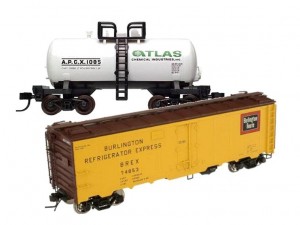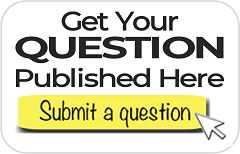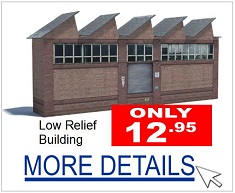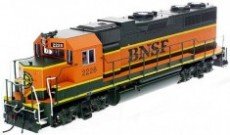Everything on model trains, model railroads, model railways, locomotives, model train layouts, scenery, wiring, DCC and more. Enjoy the world's best hobby... model railroading!
How To Make Your Layout Appear Bigger Than It Is
Experienced model railroaders use a variety of techniques to maximize space usage and to create the illusion their railroad stretch far into the distance.
One of the best ways is to give the illusion of the background scene extending further is to start with either a photographic or realistically painted backdrop. Commercially made photo backdrops are available, but many prefer to paint their own sky and background scene.
Whether painting the backdrop or using photographic printed landscape images, the trick is to create the illusion of depth and realism. The next thing is to build up the scene in front of the backdrop, to add further to the 3D effect. This can be done using trees, shrubs, grasses, people, fences, vehicles, roads, and structures.
The model buildings in this video can be seen here.
Instead of wasting valuable track or yard space with structures that are 6” or 8” deep, many hobbyists construct their background buildings just 1” or 2” deep. This clever technique can save an enormous of space, whilst still proving the illusion that the buildings are full-size, and that they extend well into the background.
These thin low relief buildings usually consist of a frontage, with part of a roof, and usually one or two side walls visible or partly visible. The buildings can be placed in front of the sky or tree lined painted or photographic backdrop.
More scenery, props, greenery, track etc can be positioned near the buildings to create the impression the layout extends considerably further than in reality it does.
It’s an expensive waste to cut up pricey plastic kits to create this type of background illusion. Instead, it is much cheaper to download and build these designs from corflute, ply, card, or foam board. They can be made exceptionally strong!
And, because the downloaded prints are like photos, no paints or airbrushing is required.
The railroad models on the modelbuildings.org website are of a high quality finish (photo-realistic) and already have fine detailing such as curtains hanging in windows, flaking paintwork, rusty pipes, mold on brickwork, cracks in concrete. Some buildings even feature items on display in shop windows.
Can You Run Older Trains With Newer Transformers and Track?
Kenneth Asks Readers:
“I recently purchased a Sothwestern Pacific set new with the new fast track, and now purchased a 2001 used Sourhwestern kit. Can I run the older 0/027 model on the newer track using the new transformer or will I have to use the older transformer?”
Modular Sectional Railroad Tracks
James asks readers:
“Is there a G Scale book on how to build modules that can be connected to other modules to make larger railroads like those I have seen for HO and N scale railroads? Do you know if anyone is building modules in this scale?”
A/C Power to Layout for MTH and Lionel
Mike asks readers a A/C O-gauge 3-rail question:
“I have many MTH and old Lionel plus Super Streets. How do I wire the 2 electrical system layout? I know that Lionel doesn’t work on 18 Volt tracks, but can I cross-over the 2 tracks?”
Fewer Box Cars On Railroads?
 When you take a look at a real railroad, or a model layout, you’ll likely see a variety of railroad freight cars (rolling stock) stretching the length of a train. You’ll probably spot standard hoppers, some boxcars, and some well-cars (used for transporting shipping containers and truck trailers).
When you take a look at a real railroad, or a model layout, you’ll likely see a variety of railroad freight cars (rolling stock) stretching the length of a train. You’ll probably spot standard hoppers, some boxcars, and some well-cars (used for transporting shipping containers and truck trailers).
In early times the industry used a lot of flat cars for moving lading (an older word to describe the freight). The early designs where reasonably basic, but as the years went by the equipment became bigger, and heavier, so there became a need for more sophisticated ways to transport larger loads and cargo of a more specific type (such as chemicals, perishables, dangerous goods, vehicles etc).
So today, a wide range of freight cars are in service replacing the once common boxcar, which railroads typically used for hauling non-liquid loads and general freight during most of the 20th century. However, if your model railroad is not modeled on the present day, then it’s likely your trains will still include plenty of traditional boxcars.
Your Ideas for a Model Railroading Poll
The model train polls published on this blog are proving very popular, but it would be good to get some of your ideas for new polls. If you have a suggestion(s) for a question(s) to be asked in future polls, then please send them in. Just use the normal Submit a Question form and that will reach us. You can even suggest possible options for answers.
Caculating Parts List for Track Plans
Anna asks readers:
“Hi! I am making my first N scale layout from a drawing that I found in an old train magazine. There is only a picture with a graph. The layout is 2’x2.5′ and I was thinking about adding more to make it 3×3. How do I make a shopping list for the tracks and such from just the picture?
Robert comments: Anna, The N Scale Track plans ebook includes 69 plans COMPLETE with parts list. The HO/OO scale ebook has another 18 plans COMPLETE with parts list.
Why do some Trains Hesitate or Stall on Track?
Article contributed by Club Member Andrew Wilkinson
 Having a train that stutters and jerks is a common problem raised by model railroaders (especially beginners in the hobby). Believe me, there’s not a lot of fun in having to prod and push a train along the track. However, these problems are often easily rectified, but first the cause(s) needs to be diagnosed.
Having a train that stutters and jerks is a common problem raised by model railroaders (especially beginners in the hobby). Believe me, there’s not a lot of fun in having to prod and push a train along the track. However, these problems are often easily rectified, but first the cause(s) needs to be diagnosed.
Obviously keeping the layout (track) and rolling stock (wheels) clean and free from dust and grime is essential, and is more often than not a factor in poor operation.
Humidity can affect track too. Using a dehumidifier can assist in keeping the room humidity to 50-55% range. A tarnished rough track can be problematic as it is likely to have a highly electrical resistant surface. Apart from reducing engine performance, tarnished track can cause wear on the pickup wheels if they become oxidized or dirty.
How to Fix Rail Joints
The same goes for rail joints, they need to operate efficiently. The connection between the each piece of track could provide enough electrical resistance to cause a train to slowdown or pause momentarily, especially on track that is at the other end of the layout. The solution in this case could include replacing worn (or loose) fish-plates and to electrically connect track pieces together using a track-power booster cable.
Fixing Locomotive Problems
Any number of other faults can result in erratic operation. With consistent use, washers, insulating bushes, and other electrically devices could show signs of wear and no longer be properly insulating the locomotive chassis electrical parts. Damaged or loose drive gears need to be fixed and properly secured to their shafts. Also watch for any wheels that work loose on their axle shaft.
Poor Power Supply Can Cause Trains to Stall or Stop
In a nutshell; model trains rely on the track rails for power. A train will slow down, or even stall, if that connection is inconsistent or broken.
Trains need enough consistent power throughout the course of the journey, whether they are close to the power source or on the other side of the layout. Erratic running could be an indication the trains are not receiving enough power, so you might need to improve the power flow. A drop in voltage can usually be fixed up by including more connections.
A drop in voltage is a likely cause if the train slows or stops just in a certain spot on the track. The distance from the power supply and the track section joints can weaken the power flow. Consider the solutions already mentioned to tighten any loose rail joiners and if needed, run another set of wiring from the power supply directly to the problem section of track. Obviously care needs to be taken to ensure each wire is connected to the correct rail.
With large model layouts, and also with most DCC systems, utilizing a bus wire (with feeders) to multiple track sections is the preferred option. The use of heavier wire (No 14 to No 10 gauge) depending on the scale and run length, is generally more productive than the rails. Smaller (No 20 to No 18) feeder wires can be joined as often as required between the rail and bus. These feeders are often connected at 6 to 12 foot intervals.
Rail joiners can also be soldered. This can definitely reduce the voltage drop, as well as helping to eliminate any rail kinks that could cause a derailment. Leaving a few joiners open will provide some room for expansion and contraction over the course of the year.
I would be interested in hearing other suggestions from readers.
If you would like to submit an article for publication please contact us here.
POLL RESULTS – Do you ever read the comments, or add a comment, under postings on this blog?
422 readers voted in our last poll which asked: Do you ever read the comments, or add a comment, under postings on this blog?
Results were as follows:
YES – I usually read the comments, but haven’t posted a comment yet (69%)
YES – I usually read the comments, and have also posted a comment(s) (14%)
NO – I’ll leave it for other model railroaders to read or post comments (8%)
NO – but now I know, so will read and/or post comments in the future (5%)
NO – I didn’t know I could read or post comments on this blog (4%)
So, the invitation goes out to everyone to get involved and post your comments. This blog is for everyone in the hobby regardless of the scale you work in, your railroading brand preferences, or whether you prefer DC or DCC.
This blog has the highest readership of any railroading blog on the internet (with thousands of visitors every week), so there will be plenty of other readers who share your particular interests in the hobby.
How to Make Space For More Track in Rail Yards
With prudent use of available space, a model railroader can sometimes find room to add more track.
The solution can be as simple as replacing large foreground buildings with ‘low relief’ buildings positioned along the background. So, instead of the buildings being somewhere between 4 to 8 inches in depth, the background buildings need only be 1 to 2 inches thick. They will still look like real full-depth buildings, especially with the careful placement of support scenery props like trees, weeds, background sky and hills.
Done well, the scene can give the illusion it stretches far off into the distance, making the layout appear to be considerable larger than it actually is in reality.















